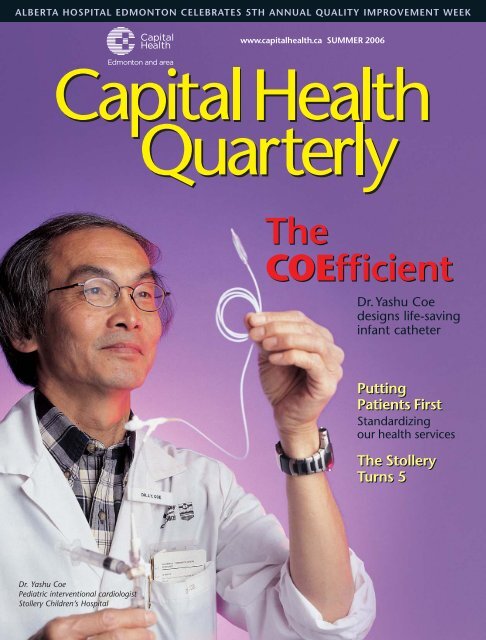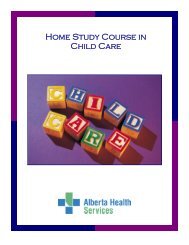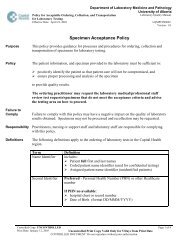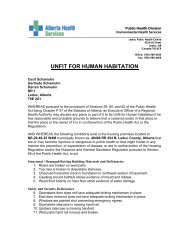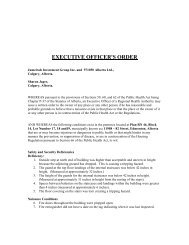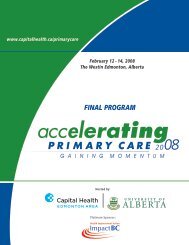The COEfficient The COEfficient - Capital Health
The COEfficient The COEfficient - Capital Health
The COEfficient The COEfficient - Capital Health
You also want an ePaper? Increase the reach of your titles
YUMPU automatically turns print PDFs into web optimized ePapers that Google loves.
ALBERTA HOSPITAL EDMONTON CELEBRATES 5TH ANNUAL QUALITY IMPROVEMENT WEEK<br />
www.capitalhealth.ca SUMMER 2006<br />
<strong>The</strong><br />
<strong>COEfficient</strong><br />
Dr. Yashu Coe<br />
designs life-saving<br />
infant catheter<br />
Putting<br />
Patients First<br />
Standardizing<br />
our health services<br />
<strong>The</strong> Stollery<br />
Turns 5<br />
Dr. Yashu Coe<br />
Pediatric interventional cardiologist<br />
Stollery Children’s Hospital
It’s hard not to get excited about an innovation in heart<br />
care that’s this big. When the doors open to the<br />
Mazankowski Alberta Heart Institute in 2007, the lives<br />
of adults and children will be bettered and saved<br />
through skill, research and state-of-the-heart technology.<br />
Sincere thanks to the Government of Alberta for its<br />
contribution of $156 million and to the University<br />
Hospital Foundation fundraising cabinet led by Bill<br />
Comrie, JR Shaw and Dennis Erker for securing $40<br />
million in private donations. This Heart Institute is<br />
destined to be among the most advanced and respected<br />
clinical care, research and education facilities in the world<br />
today. Right here in Edmonton, we’ll care for patients<br />
from Alberta, the Prairies and the Canadian North.<br />
Naturally, our maximum heart rate is attained just<br />
thinking about this building with heart. days to go.<br />
www.capitalhealth.ca/albertaheartinstitute
SUMMER 2006<br />
IN FOCUS<br />
5 Putting Patients First<br />
<strong>Capital</strong> <strong>Health</strong> takes the next step to becoming<br />
a more integrated health system by streamlining<br />
the access and standardizing the delivery of health<br />
services across the region.<br />
COLLABORATING IN CARE<br />
10 New Institute a Living Laboratory<br />
11 Naming the Edmonton Clinic<br />
12 Weight Wise for the Long Haul<br />
IN THE COMMUNITY<br />
14 Elite Transport Team<br />
BEST PRACTICES<br />
16 Stollery Children’s Hospital Turns 5<br />
17 ABACUS Research Centre<br />
18 Quality Improvement Week at<br />
Alberta Hospital Edmonton<br />
20 <strong>Health</strong> Informatics<br />
NEWS AND NOTES<br />
21 Bob Normand Joins Board<br />
21 A Resource for Research<br />
22 WebLinks<br />
20<br />
FEATURES<br />
7 Miniaturizing Tools for Tots<br />
<strong>The</strong> <strong>COEfficient</strong>, as this tot-specific catheter is<br />
called, was named after Dr. Yashu Coe, a pediatric<br />
cardiologist at the Stollery Children’s Hospital. His<br />
design, accepted around the world, has now been<br />
approved by the U.S. Food and Drug Administration.<br />
8 Pandemic Planning for Business<br />
Dr. Sherry Cooper, Chief Economist at BMO Nesbitt<br />
Burns, talks about the importance of business<br />
continuity planning at a <strong>Capital</strong> <strong>Health</strong> breakfast.<br />
16 7 18<br />
ON THE COVER: Dr. Yashu Coe by Laughing Dog Photography<br />
THIS PAGE: Dr. Nicola Shaw (left) and Dr. Shoo Lee by Stephen Wreakes/<br />
<strong>Capital</strong> <strong>Health</strong> (top left), Stollery celebration by Pat Marston/<strong>Capital</strong> <strong>Health</strong><br />
(bottom left), catheters by Laughing Dog Photography (bottom middle),<br />
AHE Quality Improvement team members clockwise from top: Janice<br />
Godbout, Susan Hample, Christine North and Rosie Thornton by<br />
Robert Strand/<strong>Capital</strong> <strong>Health</strong> (bottom right).<br />
Canada Post Publications Mail<br />
Agreement Number 40639561<br />
www.capitalhealth.ca SUMMER 2006 ~ CHQ 3
FROM THE DESK OF SHEILA WEATHERILL<br />
Putting the Patient<br />
at the Centre of Care<br />
Historically, the health system in Alberta was structured around<br />
independently-operated hospitals and<br />
services. <strong>The</strong>re was no linkage among<br />
health services or co-ordination among<br />
physicians – patients had to figure out<br />
whom to call and where to go.<br />
In becoming a health region 11 years<br />
ago, we built an integrated care model<br />
within the health system, providing<br />
a complete range of health services<br />
in addition to emergency and acute<br />
care – from home care and continuing<br />
care, to public and community health,<br />
mental health and rehabilitation.<br />
With regionalization, we centralized<br />
our governance structure and administration,<br />
and consolidated our finance,<br />
human resources, IM/IT and communications<br />
departments. But there was<br />
little standardization or co-ordination<br />
of health services among sites and<br />
sectors. Patients were still being asked<br />
to register and re-register whenever<br />
and wherever they entered the system.<br />
Today, we take the next step in our<br />
goal to become a fully integrated<br />
health system with a major initiative<br />
to standardize health services across<br />
the <strong>Capital</strong> <strong>Health</strong> region. Just as we<br />
did by linking site information systems<br />
through netCARE so patients need only<br />
register once, we are streamlining the<br />
access and delivery of health services<br />
to provide patients with a co-ordinated<br />
continuum of services to support their<br />
care and guide them through the<br />
health system.<br />
We need to integrate services both<br />
within programs and among programs<br />
to ensure collaborative, co-ordinated<br />
and comprehensive service delivery.<br />
Turn to page 5 to read about our vision<br />
and the seven key service areas which<br />
make up the projects in <strong>Capital</strong> <strong>Health</strong>’s<br />
Regional Integration initiatives.<br />
On May 30, <strong>Capital</strong> <strong>Health</strong> completed<br />
Operation Outbreak 2, its second<br />
pandemic planning tabletop exercise,<br />
to test its emergency preparedness<br />
by guiding 200 leaders through a<br />
real-life scenario. <strong>The</strong> next day, BMO<br />
Chief Economist Dr. Sherry Cooper<br />
spoke at a <strong>Capital</strong> <strong>Health</strong> breakfast on<br />
the economic impact of a pandemic.<br />
You can read about both events in<br />
this issue.<br />
Congratulations to Dr. Gerry Predy,<br />
who received the Heart and Stroke<br />
Foundation of Canada’s Leadership<br />
Award August 11 for his contributions<br />
to heart health policy. Dr. Predy<br />
established the Urban Public <strong>Health</strong><br />
Network in 18 cities across the country<br />
to allow Canada-wide collaboration<br />
on healthy public policy initiatives.<br />
I would like to welcome Bob Normand,<br />
President and CEO of ATB Financial,<br />
to the <strong>Capital</strong> <strong>Health</strong> Board. One of<br />
the primary roles of the Board is to<br />
promote the provision of integrated<br />
heath services.<br />
By building a strong customer-focused<br />
organization we can provide people<br />
with more choice in accessing health<br />
services while improving the quality<br />
and safety of patient care and the<br />
performance of the health system.<br />
In planning for a more integrated<br />
and consistent approach to delivering<br />
health services across <strong>Capital</strong> <strong>Health</strong><br />
region, we will always embrace<br />
that which places the patient and<br />
the client at the centre of care.<br />
Quite simply, we are building a<br />
health system that puts patients<br />
and clients first.<br />
Sincerely,<br />
Sheila Weatherill, C.M.<br />
President and CEO<br />
www.capitalhealth.ca<br />
<strong>Capital</strong> <strong>Health</strong> Quarterly is published by <strong>Capital</strong> <strong>Health</strong> Public Affairs.<br />
EDITOR<br />
Dawna Freeman<br />
dawnafreeman@cha.ab.ca<br />
780-482-8660<br />
ART DIRECTOR<br />
Julie Wons<br />
CONTRIBUTING WRITERS<br />
Tannis Baradziej, Ronna Bremer, Steve Buick, Dawna Freeman,<br />
Melanie Friesacher, Karen Karbashewski, Juliet Kershaw, Jeanette<br />
LaBrie-Cable, Jo-anne Nugent, Barb Petryk, Rob Stevenson<br />
CONTRIBUTING ILLUSTRATORS/PHOTOGRAPHERS<br />
Karen Karbashewski, Jeanette LaBrie-Cable, Laughing Dog<br />
Photography, Pat Marston, Robert Strand, Stephen Wreakes<br />
We welcome your story ideas and comments. Send your<br />
comments to the Editor at dawnafreeman@cha.ab.ca.<br />
Photos and articles may not be reproduced without the<br />
written consent of the Editor.<br />
HOW TO REACH US<br />
<strong>Capital</strong> <strong>Health</strong> Public Affairs<br />
1J2.51 Walter C. Mackenzie Centre<br />
8440-112 Street<br />
Edmonton, AB T6G 2B7<br />
<strong>Capital</strong> <strong>Health</strong> Quarterly is printed by Nisku Printers (1980) Ltd.<br />
on 80 lb Chorus Art Silk (50% recycled stock).<br />
© Contents copyright 2006 by <strong>Capital</strong> <strong>Health</strong>.<br />
4 CHQ ~ SUMMER 2006 www.capitalhealth.ca
IN FOCUS<br />
<strong>The</strong>re is a whole world of difference between good care<br />
and good care that is properly co-ordinated.<br />
<strong>Capital</strong> <strong>Health</strong> shows the will and the way<br />
Pushing the envelope<br />
of regional integration<br />
If Michele Lahey’s forecast is correct,<br />
<strong>Capital</strong> <strong>Health</strong> is on its way to becoming<br />
the most integrated health region in<br />
Canada.<br />
But wait, you say, isn’t <strong>Capital</strong> <strong>Health</strong><br />
already the most integrated health<br />
region in the country?<br />
Since regionalization 11 years ago,<br />
<strong>Capital</strong> <strong>Health</strong> has become an<br />
exemplary model of integrated care,<br />
merging acute and emergency care<br />
with community and long term care,<br />
public health, mental health and<br />
rehabilitation.<br />
<strong>The</strong> development of Canada’s first<br />
region-wide electronic health record,<br />
netCARE, was another leading example<br />
of integration through the use of<br />
technology, linking patient records<br />
across all sites and sectors.<br />
“Integration has as many definitions<br />
as it has degrees,” says Michele,<br />
Executive Vice-President and Chief<br />
Operating Officer, <strong>Health</strong> Services.<br />
“It may be structural, or functional,<br />
or clinical. But like our quality improvement<br />
initiatives, it’s ongoing. We have<br />
become more integrated, and with<br />
the functional electronic health record<br />
(EHR) infrastructure firmly in place,<br />
we’re in a position to take clinical<br />
integration a step further.”<br />
Michele is leading <strong>Capital</strong> <strong>Health</strong>’s<br />
vision to improve the quality of care<br />
through a more integrated approach<br />
to delivering health services across the<br />
region. With the current pressures on<br />
health care resources, it is no longer<br />
practical to expect individual programs<br />
to provide comprehensive care for<br />
today’s complexity of patient needs.<br />
“Right now, there are areas in our<br />
system that are fragmented and<br />
cumbersome. We have dozens of<br />
vertical spikes,” she says, sketching the<br />
individual silos representing <strong>Capital</strong><br />
<strong>Health</strong>’s services and programs on<br />
her notepad as she talks. “A patient<br />
has to navigate a sea of services;<br />
we don’t always make it easy for<br />
them to move among services.”<br />
<strong>The</strong>n she strikes several horizontal<br />
lines through all silos.<br />
“We need to create horizontal<br />
structures across the whole continuum.<br />
We need to integrate services both<br />
within programs and among programs<br />
to ensure collaborative, co-ordinated<br />
and comprehensive service delivery.”<br />
Clinical Integration<br />
Full segregation Linkage Co-ordination Co-operation Full integration<br />
www.capitalhealth.ca SUMMER 2006 ~ CHQ 5
IN FOCUS<br />
An integrated health system is ‘a network of organizations that provides<br />
a co-ordinated continuum of services to a defined population.’<br />
Putting the patient<br />
at the centre<br />
As <strong>Capital</strong> <strong>Health</strong> moves deeper into<br />
regional integration, it will continue<br />
to build its health system around the<br />
patient in order to reduce complexity<br />
for patients and to provide staff with<br />
a more standardized approach to<br />
caregiving.<br />
Seven key service areas have been<br />
identified for Phase I integration<br />
projects: neurosciences, chronic<br />
disease management, bone and joint<br />
health, cancer services, emergency<br />
services, ambulatory care and mental<br />
health.<br />
Some projects, like stroke and<br />
arthoplasty, are already well underway,<br />
while others such as emergency<br />
services and system capacity were<br />
added in Phase I to address ER<br />
pressures sooner.<br />
Dr. Ken Gardener, Vice-President,<br />
Medical Affairs and medical lead for<br />
Regional Integration, outlined the six<br />
key elements that are fundamental<br />
to a fully integrated health care<br />
organization:<br />
• patient-centred approach<br />
• single and/or central point of access<br />
• standardized evidence-based<br />
approach across the care continuum<br />
• information systems to link<br />
providers<br />
• continuous improvement through<br />
monitoring and evaluation<br />
• improved use of resources<br />
Success, he says, will be measured by<br />
improvements in quality and safety,<br />
access, collaboration and productivity.<br />
“We need to reduce the complexity<br />
for patients so they are supported<br />
in a timely way,” said Dr. Gardener.<br />
“And we need to create an infrastructure<br />
to support staff so they have<br />
what they need to deliver the care.”<br />
Michele says projects will follow the<br />
same basic planning framework now<br />
used to create five-year service plans,<br />
and the process will be standardized<br />
for all integration projects. “We are<br />
looking at how we deliver care for<br />
each patient group, such as orthopedics,<br />
from their first contact with<br />
<strong>Capital</strong> <strong>Health</strong> all the way through<br />
the system.”<br />
Those involved in planning the more<br />
integrated approach to delivering<br />
health services represent every health<br />
provider of that particular patient<br />
group, she says. “Together they’re<br />
asking what is the best care, what<br />
are the best practices we know of,<br />
how can we change what we do<br />
and how can we evaluate to see<br />
if we’re making a difference.”<br />
Michele admits the regional approach<br />
to integrate health services through<br />
a seamless and co-ordinated delivery<br />
of care is huge in scope given the size<br />
and complexity of <strong>Capital</strong> <strong>Health</strong>.<br />
“But it’s not magical; it’s good management.<br />
We have 11 years experience as<br />
a regional system and the health care<br />
environment is constantly evolving.<br />
To continue as we are would be to<br />
lose ground. Now we need to become<br />
a fully integrated health care organization.<br />
We are pushing the envelope,<br />
but that’s the culture of <strong>Capital</strong><br />
<strong>Health</strong>.”<br />
“We need to integrate services<br />
both within programs and<br />
among programs to ensure<br />
collaborative, co-ordinated and<br />
comprehensive service delivery.”<br />
MICHELE LAHEY<br />
EXECUTIVE VICE-PRESIDENT<br />
AND CHIEF OPERATING OFFICER,<br />
HEALTH SERVICES<br />
“We need to reduce the<br />
complexity for patients<br />
so they are supported in<br />
a timely way.”<br />
DR. KEN GARDENER<br />
VICE-PRESIDENT, MEDICAL AFFAIRS<br />
AND MEDICAL LEAD, REGIONAL<br />
INTEGRATION<br />
6 CHQ ~ SUMMER 2006 www.capitalhealth.ca
FEATURE<br />
Miniaturizing tools for tots<br />
Physician-designed<br />
infant catheter<br />
finds open market<br />
Dr.Yashu Coe,<br />
pediatric interventional cardiologist at the Stollery Children’s<br />
Hospital, says the mortality rate for the treatment of defective<br />
heart valves in infants is now zero per cent. “Here at the Stollery,<br />
we’ve never had a procedural or late mortality.”<br />
Each year, the Stollery Children’s<br />
Hospital treats five to 10 infants for<br />
aortic stenosis (a narrowed aortic valve),<br />
one of eight common abnormalities that<br />
account for approximately 80 per cent<br />
of congenital heart defects.<br />
At one time, surgery was the treatment<br />
of choice. <strong>The</strong>n, 10 to 20 years ago,<br />
angioplasty offered an alternative.<br />
This procedure involves inserting<br />
and guiding a catheter into the heart<br />
through either a vein or an artery and<br />
inflating a balloon across the valve to<br />
eliminate the severely narrow valve<br />
opening. When he first began using<br />
Adult catheter (left) guide wire is<br />
0.035 inches compared with the infant<br />
catheter (right) at 0.018 of an inch.<br />
<strong>The</strong> infant catheter is more flexible<br />
and slimmer, allowing for easier<br />
navigation through the heart.<br />
this procedure, Dr. Coe found the<br />
balloon too fragile or the catheter<br />
too big for tiny babies’ bodies, and<br />
was determined to find a solution<br />
to improve the treatment for these<br />
critically sick infants.<br />
After conducting initial research,<br />
Dr. Coe, also a Professor of Pediatrics at<br />
the University of Alberta, approached<br />
various manufacturers to help him<br />
custom design a catheter to his specifications.<br />
When he finally discovered<br />
NuMed, a U.S. manufacturer with<br />
a facility in Canada, within a month,<br />
Dr. Coe had in hand his tot-specific<br />
catheter for angioplasty operations.<br />
“What’s neat about this is that it’s small;<br />
and the balloon – it’s very, very strong.”<br />
<strong>The</strong> <strong>COEfficient</strong>, as the tool is named,<br />
has since saved the lives of many infants.<br />
<strong>The</strong> catheter is now also used to<br />
correct severely malfunctioning<br />
pulmonary valves in newborns,<br />
at times a life-threatening condition<br />
that must be addressed immediately.<br />
Angioplasty operations come with the<br />
additional blessing that “the baby can<br />
usually go home sooner,” says Dr. Coe,<br />
unlike the longer recovery period<br />
required for more invasive surgery.<br />
With its new U.S. Food and Drug<br />
Administration’s stamp of approval,<br />
the <strong>COEfficient</strong> is ready for the open<br />
market. Until recently it was little known.<br />
In fact, not long ago in Germany,<br />
a delighted Dr. Coe impressed staff<br />
at a hospital he was visiting when<br />
they proudly revealed their “new”<br />
infant catheter – then discovered<br />
the design was his.<br />
LAUGHING DOG PHOTOGRAPHY<br />
www.capitalhealth.ca SUMMER 2006 ~ CHQ 7
FEATURE<br />
Real-life Exercise Tests <strong>Capital</strong> <strong>Health</strong>’s Emerge<br />
You plan.<br />
You prepare.<br />
You react.<br />
A good plan helps your<br />
best efforts succeed.<br />
<strong>Capital</strong> <strong>Health</strong> put<br />
its emergency plan<br />
to the test by guiding<br />
its leaders through<br />
a real-life scenario.<br />
It was Operation Outbreak 2 –<br />
the scenario: suspect cases of<br />
severe respiratory illnesses surfacing<br />
in Southeast Asia and Asia. Weeks<br />
later, three suspect cases show up<br />
at the Northeast Community <strong>Health</strong><br />
Centre in Edmonton. Alberta <strong>Health</strong><br />
and Wellness is notified. <strong>Capital</strong><br />
<strong>Health</strong>’s Regional Emergency Co-ordination<br />
Centre (RECC) is activated.<br />
<strong>The</strong> pandemic planning tabletop<br />
exercise included about 200 people<br />
from <strong>Capital</strong> <strong>Health</strong>, Caritas <strong>Health</strong><br />
Group and the Alberta Cancer Board.<br />
It involved the activation of the<br />
Policy Group, the RECC and the Site<br />
Emergency Operations Centres at the<br />
University of Alberta Hospital, Stollery<br />
Children’s Hospital, Royal Alexandra<br />
Hospital, Misericordia Hospital and<br />
the Sturgeon Hospital.<br />
<strong>The</strong> scenario was introduced to<br />
the entire group. It created a buzz<br />
in the room as site and planning<br />
teams worked diligently through<br />
the exercise, responding to different<br />
circumstances as the situation became<br />
more serious. <strong>The</strong> response needed<br />
to be co-ordinated and focused on<br />
protecting the health of patients,<br />
staff, and the public.<br />
This was the second phase of Operation<br />
Outbreak. <strong>The</strong> first exercise took place<br />
in June 2005. Its success initiated<br />
planning for further, more interactive<br />
emergency response activities.<br />
“<strong>The</strong> public expects their health care<br />
needs to be met regardless of what<br />
incident has taken place. We need to<br />
be able to respond to the emergency<br />
situation and limit its effects on<br />
<strong>Capital</strong> <strong>Health</strong>’s daily operations –<br />
to deliver the standard of care people<br />
expect from our health service<br />
providers,” said Dr. Gerry Predy,<br />
<strong>Capital</strong> <strong>Health</strong>’s Vice-President of<br />
Public <strong>Health</strong> and Medical Officer<br />
of <strong>Health</strong>.<br />
“With a potential flu pandemic,<br />
employees may be sick or be home<br />
caring for family members. We need<br />
to test our emergency and business<br />
continuity plans so the public is<br />
comfortable knowing it can continue<br />
to rely on <strong>Capital</strong> <strong>Health</strong> to deliver<br />
health services.”<br />
Communication is a key component<br />
in any emergency situation. For the<br />
first time, telehealth equipment was<br />
tested as part of the tabletop exercise.<br />
It linked emergency operation centres<br />
at several different sites. <strong>The</strong> technology<br />
is a valuable tool to strengthen<br />
communication lines with <strong>Capital</strong><br />
<strong>Health</strong> sites and the RECC.<br />
“<strong>The</strong> tabletop exercise is testing<br />
the plan, not the people. If the plan<br />
8 CHQ ~ SUMMER 2006 www.capitalhealth.ca
ncy Plan<br />
DR. SHERRY COOPER<br />
Pandemic Planning – An Economist’s View<br />
JEANETTE LABRIE-CABLE/CAPITAL HEALTH (PANDEMIC EXERCISE SERIES)<br />
<strong>Capital</strong> <strong>Health</strong>’s second pandemic<br />
planning tabletop exercise this spring<br />
involved 200 people from <strong>Capital</strong> <strong>Health</strong>,<br />
Caritas and Alberta Cancer Board.<br />
is well-designed, it will allow our staff<br />
to succeed in their designated roles.<br />
No plan is perfect. We need to figure<br />
out where those gaps are and what<br />
lessons can be learned,” said Eric Bone,<br />
<strong>Capital</strong> <strong>Health</strong>’s Regional Director,<br />
Office of Emergency Preparedness.<br />
“<strong>The</strong> best written plan is one that can<br />
be changed at a moment’s notice.”<br />
<strong>The</strong> value of Operation Outbreak<br />
was in the dialogue that took place<br />
during the exercise. Communication<br />
strategies were essential for the team<br />
to work together to relay key planning<br />
messages to staff.<br />
“Exercising a plan allows <strong>Capital</strong><br />
<strong>Health</strong> staff to understand the process.<br />
It will identify planning weaknesses<br />
and resource gaps, clarify roles and<br />
responsibilities, improve co-ordination,<br />
test equipment and reassure the public<br />
that <strong>Capital</strong> <strong>Health</strong> is prepared,” said<br />
Eric.<br />
At the end of the day – lessons were<br />
learned. <strong>The</strong> emergency preparedness<br />
plan will be further fine-tuned, taking<br />
<strong>Capital</strong> <strong>Health</strong> another step closer to<br />
effectively handling pandemic influenza<br />
or any other emergency situation.<br />
<strong>The</strong> human and social costs of a possible pandemic are unimaginable.<br />
But experts predict an outbreak could also have devastating effects on our<br />
economy – potentially costing more than $3 trillion worldwide. Businesses<br />
of all sizes need to manage the risk. Effective plans can help minimize the<br />
damage to the economy and individual operations.<br />
Dr. Sherry Cooper, Chief Economist at BMO Nesbitt Burns, shared her expertise<br />
on the importance of business continuity planning with dozens of businesses<br />
at a <strong>Capital</strong> <strong>Health</strong> breakfast in May. Dr. Cooper estimates a flu pandemic<br />
will cost the Canadian economy anywhere from $20 to $60 billion, depending<br />
on the severity of the outbreak. She predicts the industries most affected will<br />
be poultry, tourism, hospitality, entertainment, sports facilities, food services<br />
and luxury goods suppliers.<br />
Preparing now is critical to limiting the effects of a pandemic. Companies<br />
should be ready to deal with absenteeism, changes in the delivery of public<br />
services, and a slowdown in the global economy.<br />
“Governments, businesses, health services and individuals must continue to<br />
develop continuity and emergency preparedness plans and test and retest these<br />
plans as well as revise them as the situation changes,” says Dr. Cooper.<br />
Business should expect a 30 per cent reduction in the workforce. Cross-training<br />
is essential to have employees prepared to step into critical roles and companies<br />
should plan to have staff work from home if necessary.<br />
Pandemic is unlike other natural disasters, it can be prolonged, with no fixed<br />
location and no set end date.<br />
Dr. Cooper says it’s important to remember that even with a severe pandemic,<br />
roughly 98 per cent of the world’s population will survive. Borders will reopen<br />
and the flow of goods and services will start again. <strong>The</strong> global economy will move<br />
forward and businesses and government will have learned valuable lessons.<br />
For more information on pandemic planning check <strong>Capital</strong> <strong>Health</strong> website at:<br />
http://www.capitalhealth.ca/pandemicbusinesschecklist<br />
www.capitalhealth.ca SUMMER 2006 ~ CHQ 9<br />
STEPHEN WREAKES/CAPITAL HEALTH
COLLABORATING IN CARE<br />
New ‘living laboratory’ puts women and children first<br />
Wendy Beaudoin with three-year-old<br />
daughter Olivia and Dr. Thierry Lacaze,<br />
neonatologist and Acting Director of the<br />
Women and Children’s <strong>Health</strong> Research<br />
Institute.<br />
THE UNIVERSITY OF ALBERTA AND<br />
<strong>Capital</strong> <strong>Health</strong> have announced<br />
a joint commitment to create the<br />
region’s first-ever research institute<br />
dedicated to women and children’s<br />
health. Thanks to commitments of<br />
$37 million from our communities<br />
through the Stollery Children’s Hospital<br />
($30 million) and Royal Alexandra<br />
Hospital ($7 million) Foundations,<br />
the new institute will be a potent<br />
force in the national research agenda<br />
in two critical fields.<br />
Clinicians will work with scientists<br />
across six University of Alberta faculties<br />
in the Women and Children’s <strong>Health</strong><br />
Research Institute to study and treat<br />
the full range of women and children’s<br />
health issues, from diagnosing and<br />
treating illness in utero and developing<br />
new treatments for autism, epilepsy<br />
and other child health problems,<br />
to new services for mature women.<br />
<strong>The</strong> institute will consist of three<br />
linked research centres:<br />
1. A children’s clinical research<br />
centre, to be located in the future<br />
Edmonton Clinic across 114 Street<br />
from the Walter C. Mackenzie Centre<br />
2. A women’s clinical research centre,<br />
to be part of the future Lois Hole<br />
Hospital for Women within the<br />
Robbins Pavilion, being built on<br />
the Royal Alexandra Hospital site<br />
3. A basic research centre, to be<br />
located within the future Discovery<br />
Centre being built on 87 Avenue<br />
just north of the University of<br />
Alberta Hospital site<br />
10 CHQ ~ SUMMER 2006 www.capitalhealth.ca<br />
“<strong>The</strong>se three centres will be the ‘life’<br />
in the ‘living laboratory’ that we’re<br />
envisioning for these new facilities,”<br />
says Dr. Terry Klassen, <strong>Capital</strong> <strong>Health</strong>’s<br />
Regional Clinical Program Director for<br />
Child <strong>Health</strong> and University of Alberta<br />
Chair of Pediatrics. “This is the leading<br />
edge of health sciences, where we<br />
study, develop, apply and evaluate<br />
new treatments as we care for patients<br />
in real time. It’s an exciting model and<br />
nowhere else in Canada is it possible<br />
on the scale we’re building here.”<br />
“This is a great day for patients and<br />
all the different health professionals<br />
who care for them,” adds Dr. Wylam<br />
Faught, Site Chief for Women’s <strong>Health</strong><br />
at the Royal Alexandra Hospital and<br />
Chair of Obstetrics and Gynecology<br />
for the University, at the May 24 news<br />
conference. “Women will have access<br />
to state-of-the-art care, and the work<br />
done here will benefit people right<br />
across Canada. <strong>The</strong> institute will<br />
not only build on many established<br />
strengths in the region but also help<br />
create new areas of expertise, like a<br />
mature women’s clinic at the Royal<br />
Alexandra.”<br />
Planning for the institute is being<br />
led by Dr. Thierry Lacaze, inaugural<br />
Acting Director. Dr. Lacaze is a neonatologist<br />
at the Stollery Children’s<br />
Hospital and Research Director in<br />
the University of Alberta Department<br />
of Pediatrics. He was recruited to<br />
Edmonton in 2003 from the University<br />
of Paris.<br />
<strong>The</strong> institute will include four new<br />
endowed research Chairs – starting<br />
with Dr. Lonnie Zwaigenbaum,<br />
who is joining the Stollery team this<br />
summer from McMaster University.<br />
Dr. Zwaigenbaum is known internationally<br />
as the author of a 2005<br />
study that pinpointed signs of incipient<br />
autism in infants as young as 12 months,<br />
paving the way for earlier and more<br />
effective intervention.<br />
<strong>The</strong> institute will be devoted to<br />
making life better for patients like<br />
three-year-old Olivia Beaudoin, who<br />
dropped in to the news conference<br />
along with mom Wendy, a nurse<br />
at the Stollery. Wendy told reporters<br />
she’s grateful for Olivia’s care – which<br />
started with a premature birth and<br />
eventually included five neurosurgeries.<br />
“Nobody should have to live their<br />
first year in the hospital, and so I think<br />
this is a huge step as far as research<br />
money to develop different techniques<br />
and different equipment. As a community,<br />
we need to strive for no surgeries<br />
for children, and this is a huge step in<br />
that direction.”<br />
<strong>Capital</strong> <strong>Health</strong> President and CEO,<br />
Sheila Weatherill, says Alberta is in<br />
the midst of a “baby boom” as young<br />
families move here for jobs, so the<br />
institute couldn’t be coming at a<br />
better time. “Our region’s population<br />
has grown eight per cent in the last<br />
five years; but births in our hospitals<br />
are up by 15 per cent, partly due to<br />
steadily growing numbers of moms<br />
and babies referred from northern<br />
Alberta, the Northwest Territories<br />
and elsewhere.” In total, she says, the<br />
region expects about 15,000 babies<br />
to be born here this year.<br />
PAT MARSTON/CAPITAL HEALTH
Community<br />
Pride Inspires<br />
the Name<br />
STEPHEN WREAKES/CAPITAL HEALTH<br />
the<br />
Mayo Clinic and the Cleveland<br />
Clinic draw patients from around<br />
the world, and in five years time, so<br />
will the Edmonton Clinic. In 2011,<br />
<strong>Capital</strong> <strong>Health</strong> and the University of<br />
Alberta will officially open the model<br />
for future academic health centres<br />
in North America and highlight<br />
Edmonton’s place on the health<br />
care map.<br />
Formerly called the <strong>Health</strong> Sciences<br />
Ambulatory Learning Centre, the<br />
new name is the strategic outcome<br />
brainstormed by University of Alberta<br />
President, Indira Samarasekera, and<br />
<strong>Capital</strong> <strong>Health</strong> President and CEO,<br />
Sheila Weatherill, who says, “<strong>The</strong><br />
name Edmonton Clinic reflects the<br />
pride we have in our community.”<br />
<strong>The</strong> $577-million clinic will concentrate<br />
health services, such as day clinics<br />
and diagnostic services from the<br />
University of Alberta Hospital and<br />
Stollery Children’s Hospital, into a<br />
“one-stop” family-centred complex.<br />
<strong>The</strong> result will free up space on existing<br />
wards and about 200 inpatient hospital<br />
beds.<br />
In addition to health services, the clinic<br />
will create interdisciplinary educational<br />
environment for 6,000 students from<br />
the university’s health sciences faculties.<br />
It is an innovative solution to the<br />
needs of a maturing capital region.<br />
Sheila elaborates, “This plan will help<br />
to ensure that we have the beds and<br />
trained health service providers to<br />
meet the current and future health<br />
needs of our growing and aging<br />
population.”<br />
<strong>The</strong> Edmonton Clinic will serve approximately<br />
one million patients annually.<br />
Deb Gordon, Vice-President and Chief<br />
Operating Officer of the University of<br />
Alberta Hospital and Stollery Children’s<br />
Hospital, says, “<strong>The</strong> Edmonton Clinic<br />
will integrate first-rate facilities,<br />
the electronic health record, and<br />
sophisticated scheduling systems so<br />
rural patients receive expert testing,<br />
advice and treatment quickly.”<br />
Decreased waiting times will see more<br />
patients being treated, and patients<br />
with complicated conditions won’t<br />
have to travel as much.<br />
<strong>The</strong> 168,000 square-metre clinic<br />
is in the design stage, which will take<br />
about a year. “Detailed planning is<br />
complete and now <strong>Capital</strong> <strong>Health</strong> and<br />
the University of Alberta are assembling<br />
teams of designers and builders,”<br />
says Brent Skinner, Chief Planning<br />
Officer for <strong>Capital</strong> <strong>Health</strong>. “Because<br />
the centre has a separate design<br />
team for both clinic and academic<br />
components, we’ve appointed a<br />
master architect, Mark Henderson<br />
of Callison Architecture, to ensure<br />
the design teams are working towards<br />
a common vision.”<br />
Construction of the Edmonton Clinic<br />
will be tendered in phases with the<br />
first stage beginning in spring 2007.<br />
<strong>The</strong> clinic will be located on the<br />
west side of 114 Street, next to<br />
the LRT station and connected to<br />
the University of Alberta Hospital<br />
by a pedway.<br />
www.capitalhealth.ca SUMMER 2006 ~ CHQ 11
COLLABORATING IN CARE<br />
Get Weight Wise f<br />
TOP: Johanna Dietrich, <strong>Capital</strong> <strong>Health</strong><br />
Website Content Manager; Dr. Richard<br />
Lewanczuk, Regional Medical Director,<br />
Chronic Disease Management and Professor<br />
of Endocrinolgy and Metabolism at the<br />
University of Alberta; and John Stanton,<br />
Community Ambassador for Weight Wise<br />
MIDDLE: Tracy Friesen, Integration Pilates<br />
BOTTOM: Gizmo Williams, Ex-Eskimos<br />
football player<br />
TOP: Anastasia Rozhdestvensky, Dance<br />
Alberta<br />
BOTTOM: Marg Zapf, executive associate<br />
for Joanna Pawlyshyn, executive lead<br />
for Weight Wise, and Vice-President<br />
and Chief Operating Officer of<br />
Royal Alexandra Hospital<br />
TOP: Dr. Geoff Ball, Director of <strong>Capital</strong><br />
<strong>Health</strong> Pediatric Centre for Weight and<br />
<strong>Health</strong> and Assistant Professor at the<br />
Department of Pediatrics at the university<br />
MIDDLE: Leah Gravells, Manager of<br />
Nutritional Services, <strong>Capital</strong> <strong>Health</strong><br />
BOTTOM: Velerie Chowaniec, Edmonton<br />
Yoga Studio<br />
12 CHQ ~ SUMMER 2006 www.capitalhealth.ca
or the long haul<br />
KAREN KARBASHEWSKI/CAPITAL HEALTH<br />
New effort promotes participation,<br />
lifestyle changes<br />
<strong>Capital</strong> <strong>Health</strong> is putting residents in the region in the<br />
driver’s seat with their new Weight Wise In It for the Long<br />
Haul initiative, a drive that is geared at helping residents<br />
eat healthier and increase their activity level while reducing<br />
their Body Mass Index and waist circumference.<br />
“We know that change will not occur<br />
overnight and that’s why we are in<br />
this for the long haul,” says Joanna<br />
Pawlyshyn, executive lead for <strong>Capital</strong><br />
<strong>Health</strong>’s Weight Wise initiative and<br />
Vice-President and Chief Operating<br />
Officer of Royal Alexandra Hospital.<br />
“We want to help residents in this<br />
region become healthier by providing<br />
them with information, tools and<br />
the incentive to help them become<br />
the most weight wise population<br />
in the country.”<br />
Weight Wise In It for the Long Haul<br />
is part of the larger Weight Wise initiative<br />
that <strong>Capital</strong> <strong>Health</strong> introduced<br />
last year. This comprehensive approach<br />
to addressing the obesity epidemic<br />
that exists in our population includes<br />
a number of programs and services<br />
ranging from promoting healthy<br />
lives to offering bariatric surgery for<br />
extremely obese adults. All of these<br />
efforts are designed to help adults<br />
and children reach healthy weights<br />
while supporting them to make lifestyle<br />
changes for improved health.<br />
Essentially it’s about creating healthy<br />
weights for healthy lives.<br />
Part of the Weight Wise In It for the<br />
Long Haul effort includes putting the<br />
tools and information into the hands<br />
of the public so that they can make<br />
wise and healthy decisions about<br />
the food that they eat, their activity<br />
levels, and other lifestyle factors.<br />
Using the interactive Weight Wise<br />
website residents can register<br />
to receive monthly newsletters,<br />
weekly reminders about inputting<br />
their progress on eating healthy<br />
and increasing their activity levels,<br />
as well as tracking their weight loss<br />
and waist circumference. All this<br />
is available just by signing up at<br />
www.capitalhealth.ca/weightwise.<br />
<strong>Capital</strong> <strong>Health</strong> will also work with<br />
its partners and others in the communities<br />
so that they can join in on the<br />
journey and help residents reach our<br />
objective – healthy weights for healthy<br />
lives for both children and adults.<br />
“We know that obesity is not something<br />
that the health system can<br />
tackle alone. It requires each one<br />
of us as individuals and as family<br />
members and community members<br />
to make wise choices about diet,<br />
exercise, and creating supportive<br />
environments to help people make<br />
good decisions,” says John Stanton,<br />
Community Ambassador for Weight<br />
Wise.<br />
“Becoming more weight wise is about<br />
making long-term commitments and<br />
lifestyle changes and that’s what we are<br />
looking to achieve with this exciting<br />
new effort. I encourage residents<br />
to sign up and join us as we work<br />
together to improve the health of<br />
our region.”<br />
Members of <strong>Capital</strong> <strong>Health</strong>’s<br />
Weight Wise Community Network<br />
support the prevention and<br />
management of weight and<br />
obesity issues and help individuals<br />
to improve healthy living habits.<br />
To find out how you can become<br />
a Network Member visit:<br />
www.capitalhealth.ca/weightwise<br />
CHIP – Coronary <strong>Health</strong><br />
Improvement Program<br />
Centre for Cognitive<br />
Behavioral <strong>The</strong>rapy<br />
Changes for Women<br />
City of Edmonton –<br />
Leisure, Sports and<br />
Fitness Facilities<br />
Club Fit Corporation<br />
Fit N Well Personal<br />
Training Inc.<br />
Kwantum Wellness Centre<br />
MacEwan Centre for<br />
Sport and Wellness<br />
Maximum Motion Personal<br />
Fitness Training, Inc.<br />
Rejuvenation <strong>Health</strong><br />
Services, Inc.<br />
Running Room Canada, Inc.<br />
Strathcona County,<br />
Recreation, Parks and Culture<br />
University of Alberta<br />
Fitness and Lifestyle Centre<br />
Weight Watchers of<br />
Alberta, Ltd.<br />
YMCA Edmonton<br />
www.capitalhealth.ca SUMMER 2006 ~ CHQ 13
IN THE COMMUNITY<br />
Stollery’s PICU celebrates 10 Years<br />
<strong>The</strong> sky’s the<br />
limit for this Elite<br />
Transport Team<br />
RN Joanna Byers sits beside the transport sled in the plane with<br />
flight paramedic David Hole behind the monitor.<br />
ozens of pairs of<br />
winter boots are<br />
lined up and ready<br />
to be laced for a<br />
mad dash, even in<br />
the heat of Alberta’s<br />
dry summer.<br />
<strong>The</strong>y belong to an elite<br />
group of specially trained<br />
physicians, nurses and respiratory<br />
therapists who make up the Stollery<br />
Children’s Hospital’s Pediatric Intensive<br />
Care Unit (PICU) transport team.<br />
This team provides specialized care<br />
of severely ill children during hospitalto-hospital<br />
transfers and transports by<br />
ambulance, helicopter and airplane.<br />
<strong>The</strong> team can be mobilized for a trip<br />
as far as the Arctic in just 20 minutes.<br />
This month, the PICU transport team<br />
celebrates its 10th anniversary.<br />
“In 1996, the first formally trained<br />
PICU transport team in Alberta was<br />
launched,” says the group’s Medical<br />
Director Dr. Allan de Caen. “We found<br />
that there were children in hospitals<br />
within Edmonton and surrounding<br />
rural communities who were critically<br />
ill and needed not only definitive care<br />
from Pediatrics within Edmonton, but<br />
needed to be transported to us without<br />
deteriorating en route. For this<br />
reason, a specialized PICU transport<br />
team was developed.”<br />
A decade later, the team is now considered<br />
one of the busiest in Canada<br />
and serves the largest geographic area,<br />
stretching from parts of eastern B.C.<br />
and the Yukon, across the central<br />
Arctic, and extending down into<br />
eastern Saskatchewan and southern<br />
Alberta as necessary. <strong>The</strong> team can<br />
bring the resources of the Stollery<br />
Children’s Hospital’s Pediatric Intensive<br />
Care Unit to the patient’s bedside.<br />
“We’ve learned to improvise in some<br />
very unusual situations,” says the<br />
team’s Unit Manager, Vanessa French.<br />
“We’ve coped with IV lines freezing in<br />
the Arctic, monitors that stop working<br />
in bitter cold conditions, and been<br />
COURTESY PICU TRANSPORT TEAM (PLANE)<br />
14 CHQ ~ SUMMER 2006 www.capitalhealth.ca
Stollery Children’s Hospital’s<br />
Pediatric Intensive Care Unit<br />
transport team:<br />
Back row, left to right:<br />
Eileen Heidler (RT), Shevaun<br />
Clark (RT), Darrell Derkach (RT),<br />
Shannon Duncan (RN), Kelly<br />
Stabler (RT), Colleen Gresiuk<br />
(RN), Dr. Jon Duff, Lindsay<br />
Lonsdale (RT), Christine Bichai<br />
(RT), Dr. Allan de Caen, Dave<br />
Schoepp (RT), Karen Tomlinson<br />
(RN), Esther Weathers (RT),<br />
Vanessa French (unit Manager).<br />
Front row, left to right:<br />
Joy Mekechuk (RN), Misty Reis<br />
(RN), Debra Anderson (RN),<br />
Tonia Polak (RN) Klara Vigen<br />
(RN), Cindi Ryan (RT).<br />
PAT MARSTON/CAPITAL HEALTH (GROUP)<br />
faced with a dispatch to pick up one<br />
critically ill child and on arrival learning<br />
we needed to transport three.”<br />
In the past 10 years, 2,500 sick children<br />
from the <strong>Capital</strong> <strong>Health</strong> region and<br />
beyond have been helped by this<br />
group. One of the most memorable<br />
and challenging transports occurred<br />
last summer when the team was asked<br />
to transport a cardiac patient from<br />
Winnipeg to the Stollery Children’s<br />
Hospital.<br />
Respiratory therapist, Kelly Stabbler,<br />
was part of the mission along with<br />
the Stollery Children’s Hospital’s Extracorporeal<br />
Life Support Team. “<strong>The</strong>re<br />
was so much equipment involved that<br />
we had to use a military Hercules<br />
aircraft for the transport. It took an<br />
amazing amount of co-ordination<br />
<strong>The</strong> team can be mobilized for a trip<br />
as far as the Arctic in just 20 minutes.<br />
with the medical team in Winnipeg,<br />
the emergency medical services<br />
personnel, even Winnipeg’s fire<br />
department.”<br />
<strong>The</strong> sky remains the limit for this<br />
team as it welcomes another decade<br />
of providing critical care for children.<br />
“We want to see an increase in our<br />
role in outreach education,” according<br />
to Dr. de Caen. “It takes time to<br />
reach most of our referral centres,<br />
and whatever we can do to better<br />
prepare the health care team in those<br />
centres to care for critically ill children<br />
before we arrive will ultimately<br />
make a difference in the outcome<br />
of children.”<br />
www.capitalhealth.ca SUMMER 2006 ~ CHQ 15
IN THE COMMUNITY<br />
<strong>The</strong> Stollery Children’s Hospital Turns 5<br />
LEFT: Six-year-old Lauryn Stubbs is with<br />
sisters Eden and Morganne, Dad Martin<br />
and Mom Jacqueline.<br />
BELOW, TOP: Lauryn presents her framed<br />
birthday card to Premier Ralph Klein,<br />
while Mom and <strong>Capital</strong> <strong>Health</strong> Board<br />
Chair Neil Wilkinson look on.<br />
BELOW, MIDDLE: Dr. Klassen, Premier Klein<br />
and Michele Lahey, Executive Vice-President<br />
and Chief Operating Officer, <strong>Health</strong> Services,<br />
watch the children blow out the candles.<br />
BELOW, BOTTOM: Premier Klein signs<br />
the keepsake banner.<br />
Premier Ralph Klein joins patients, physicians,<br />
staff and guests at the Stollery’s fifth birthday<br />
party on August 3.<br />
“It’s been great to see the Stollery grow into<br />
a centre of excellence, not just for Albertans<br />
but for all Canadians,” said the Premier,<br />
who received a special birthday card from<br />
six-year-old oncology patient Lauryn Stubbs.<br />
Several former Stollery patients were on hand<br />
to sing Happy Birthday and blow out the candles<br />
on the teddy bear cake.<br />
“Partnerships among <strong>Capital</strong> <strong>Health</strong>, the University of Alberta<br />
and our community as a whole have allowed us to become<br />
one of the top pediatric facilities in North America in just<br />
five years,” said Dr. Terry Klassen, Regional Clinical Program<br />
Director, Child <strong>Health</strong>, and Chair, Pediatrics, Faculty of<br />
Medicine and Dentistry, University of Alberta.<br />
<strong>The</strong> Stollery was granted official hospital status in 2001<br />
and this year will receive 140,000 patients visits.<br />
PAT MARSTON/CAPITAL HEALTH<br />
16 CHQ ~ SUMMER 2006 www.capitalhealth.ca
BEST PRACTICES<br />
ABACUS Brings Diversity of Professionals<br />
and Technologies Under One Roof<br />
Artistic rendering of ABACUS<br />
<strong>The</strong> Alberta Cardiovascular<br />
and Stroke Research Centre<br />
(ABACUS) is a new “research<br />
hospital within a hospital.”<br />
Located in the lower level<br />
of the Mazankowski Alberta<br />
Heart Institute, it’s the only<br />
Canadian research centre of<br />
its kind physically integrated<br />
into an acute care setting.<br />
It will assemble scientists, health care<br />
professionals, clinicians and trainees<br />
under one roof to focus on research<br />
into the prevention, detection and cure<br />
for cardiovascular disease and stroke.<br />
Heart disease, stroke, and blood vessel<br />
or vascular disease make up cardiovascular<br />
disease – the leading cause of<br />
death in Canadian women and men.<br />
“<strong>The</strong> facility is what the Canada<br />
Institutes of <strong>Health</strong> Research envisions<br />
as the optimum way of doing research,”<br />
says Dr. Stephen Archer, Scientific<br />
Director of the centre. “ABACUS is<br />
a collection of all things needed for<br />
a research hospital.”<br />
<strong>The</strong> facility includes an area for<br />
clinical research on heart attack and<br />
stroke patients, a basic science lab<br />
to study disease at a cellular level<br />
and a clinical trials area where new<br />
drugs and protocols are tested. Soon<br />
to follow is a wireless classroom.<br />
<strong>The</strong> $20 million ABACUS Research<br />
Centre, scheduled to open this fall, has<br />
been supported by the University of<br />
Alberta Hospital Foundation, Canada<br />
Foundation for Innovation, and both<br />
federal and provincial governments.<br />
ABACUS complements the vision<br />
of the Mazankowski Alberta Heart<br />
Institute for a future where cardiovascular<br />
disease is no longer the<br />
leading cause of death in Canada<br />
and the best health care is available<br />
here in Alberta. It does so by pushing<br />
the research envelope to find new<br />
and better ways to prevent and<br />
treat heart disease.<br />
Its location in the heart institute will<br />
enable researchers to actually be able<br />
to study patients in the middle of<br />
their cardiovascular event in a hospital<br />
setting. Patient’s medical needs can<br />
be tended to while researchers study<br />
their event as it is happening.<br />
“It’s a hot first,” says Dr. Archer.<br />
“<strong>The</strong> design of ABACUS is both<br />
philosophical and practical, and<br />
will knock down barriers between<br />
biology, radiology, cardiology and<br />
neurology.”<br />
www.capitalhealth.ca SUMMER 2006 ~ CHQ 17
BEST PRACTICES<br />
From healthier vending machine products to Supported<br />
Patient Employment in the community, Rosie Thornton<br />
has seen her share of quality initiatives during her time<br />
as Quality Improvement Coordinator at Alberta Hospital<br />
Edmonton (AHE). That’s what makes AHE’s annual Quality<br />
Improvement Week so special to her.<br />
Left to right:<br />
Christine North, Quality Improvement<br />
Coordinator – Geriatric Psychiatry<br />
Janice Godbout, Quality Improvement<br />
Coordinator – Adult Psychiatry<br />
Rosie Thornton, Quality Improvement<br />
Coordinator, AHE Site<br />
Susan Hample, Quality Improvement<br />
Administrative Assistant<br />
Alberta Hospital Edmonton<br />
Celebrates its Fifth Annual<br />
Quality Improvement Week<br />
“This is a positive way to reinforce the<br />
principles of quality improvement in<br />
a positive and collaborative fashion,”<br />
says Rosie, who has worked at the<br />
hospital since 2001. “We wanted to<br />
heighten staff’s awareness of quality<br />
improvement initiatives in all areas of<br />
the hospital and to show that everyone<br />
from management to front line staff<br />
are involved.”<br />
2006 also marked the launch of<br />
the Steps to a <strong>Health</strong>ier You site-wide<br />
initiative, which looks at increasing a<br />
patient’s physical activity and teaching<br />
patients to make healthier nutritional<br />
choices. Building on this initiative, a<br />
committee looked at healthier vending<br />
options at this site for both patients and<br />
staff. Working with a clinical dietician,<br />
the new project labels vending items<br />
as green (healthy choice), yellow<br />
(use in moderation) and red (choose<br />
infrequently), with the intention of<br />
increasing the number of green items<br />
individuals choose. Accompanying<br />
the changes will be in-services and<br />
other nutritional teaching to ensure<br />
ROBERT STRAND/CAPITAL HEALTH<br />
18 CHQ ~ SUMMER 2006 www.capitalhealth.ca
users are aware of what the labels<br />
mean, and what makes the “green”<br />
items healthier and better choices.<br />
Alberta Hospital Edmonton has<br />
celebrated five Quality Improvement<br />
Weeks, the most recent in June 2006,<br />
each highlighting the progress that’s<br />
been made on a variety of projects.<br />
Another component of the celebrations<br />
is the Staff Recognition day, a twohour<br />
open house held at the Dorran<br />
Auditorium. Featuring education<br />
displays that showcase the evolution<br />
of quality at AHE, research, and highlights<br />
from the other services within<br />
the Regional Mental <strong>Health</strong> Program,<br />
the event also recognizes the top five<br />
annual initiatives from AHE as voted<br />
on by hospital employees. <strong>The</strong> focus<br />
is projects that contribute significantly<br />
to patient care. It is a time to recognize<br />
and thank staff for their valuable contributions<br />
and dedication to improving<br />
the system for enhanced patient care.<br />
Hospital staff members enjoy the opportunity<br />
to celebrate their successes.<br />
“Staff also has access throughout<br />
the year to a registry of completed<br />
and ongoing QI projects to view all<br />
the initiatives since 1999. <strong>The</strong> staff<br />
is now able to apply best practices<br />
to a number of similar quality issues,<br />
without having to re-invent the wheel,”<br />
says Rosie, who leads a team of quality<br />
improvement professionals at AHE.<br />
“<strong>The</strong> quality improvement registries<br />
are now online at the AHE intranet site,<br />
so people can access them whenever<br />
they want.”<br />
“<strong>The</strong> staff recognition component<br />
of AHE’s annual Quality Improvement<br />
Week is so important,” says Paula Tyler,<br />
Vice-President and Chief Operating<br />
Officer for Mental <strong>Health</strong>. “Quality<br />
Improvement is most successful at the<br />
grass roots level, with front-line staff<br />
identifying an area for improvement<br />
and putting together a team to address<br />
and resolve the issue. <strong>The</strong> large majority<br />
of projects are completed by frontline<br />
staff with the full support of their<br />
supervisors – that’s what makes this<br />
week so special.”<br />
Examples of previous initiatives<br />
include the extremely successful<br />
On Time, Every Time, a project undertaken<br />
by Transportation Services to<br />
determine the number and reason for<br />
missed or late patient appointments.<br />
By gathering data about circumstances<br />
surrounding transportation issues,<br />
the team was able to determine that<br />
purchasing a small wheelchair van to<br />
help accommodate the transport of<br />
patients to their destinations would<br />
help them meet their goal of being<br />
on time, every time.<br />
“<strong>The</strong> objective of Quality Improvement<br />
Week is to strengthen the quality<br />
culture of <strong>Capital</strong> <strong>Health</strong>,” says Paula,<br />
who notes the projects from AHE aspire<br />
to the same success as other regional<br />
quality programs such as netSAFE,<br />
Good Catch and the new medication<br />
management program at the University<br />
of Alberta Hospital. “As we strive<br />
to increase our quality of service at<br />
Alberta Hospital Edmonton, we are<br />
helping raise the quality bar across<br />
the region.”<br />
Over the past five years the events of<br />
Alberta Hospital Edmonton’s Quality<br />
Improvement Week have grown<br />
exponentially. Last year more than<br />
300 people attended the Recognition<br />
Day event, up from 160 at the second<br />
annual event in 2003.<br />
“164 quality improvement projects<br />
have been presented to the Site<br />
QI Committee from December<br />
1999 to March 2005,” says Rosie.<br />
“<strong>The</strong>re is no question that the quality<br />
improvement culture at AHE will<br />
continue to be an important focus<br />
for years to come.”<br />
www.capitalhealth.ca<br />
Your reliable source for<br />
health information.<br />
From where to find a physician to learning<br />
more about staying healthy and managing<br />
chronic illness, <strong>Capital</strong> <strong>Health</strong>'s website is<br />
your personal 24-hour resource for health<br />
information. Look up a wide range of<br />
health topics, procedures, current events<br />
or the latest research and technology<br />
updates in the <strong>Capital</strong> region. You can<br />
even access the physician-approved<br />
health advice from <strong>Capital</strong> <strong>Health</strong> Link.<br />
All from the convenience of your home.<br />
<strong>Capital</strong> <strong>Health</strong> aims to keep health information<br />
and advice available to you,<br />
when you need it. So bookmark us today<br />
for a quick and convenient way to find the<br />
information you need to make better health<br />
choices for you and your family.<br />
Call 408-LINK (5465)
BEST PRACTICES<br />
Leading<br />
the Way<br />
in <strong>Health</strong> Informatics<br />
Her interest in technology is apparent when you walk into<br />
her office. Her focus on patient care is evident when you leave.<br />
“My interest is in people and organizational<br />
issues,” says a leading expert<br />
in health informatics, “and coming<br />
to Edmonton is a natural progression<br />
in that interest.”<br />
In April, Dr. Nicola Shaw was appointed<br />
as the region’s first Research Chair of<br />
<strong>Health</strong> Informatics, a position jointly<br />
created by <strong>Capital</strong> <strong>Health</strong> and the<br />
Faculty of Medicine and Dentistry.<br />
She is based in the Integrated Centre<br />
for Care Advancement through<br />
Research (iCARE), also a joint partnership<br />
between <strong>Capital</strong> <strong>Health</strong> and the<br />
University of Alberta.<br />
Recruited from the Centre for <strong>Health</strong>care<br />
Innovation and Improvement,<br />
Child and Family Research Institute<br />
in Vancouver, Dr. Shaw concentrates<br />
on the implementation, development,<br />
and the evaluation of electronic patient<br />
records in primary care. Dr. Shoo Lee,<br />
Scientific Director of iCARE, is enthusiastic<br />
about the association, “She is<br />
a great addition to the team. <strong>Health</strong><br />
informatics is a critical piece for the<br />
improvement of patient care.”<br />
20 CHQ ~ SUMMER 2006 www.capitalhealth.ca<br />
Dr. Shaw is applying her expertise in<br />
health outcomes research on a strategic<br />
level with <strong>Capital</strong> <strong>Health</strong> to evaluate<br />
and enhance netCARE’s potential.<br />
netCARE is <strong>Capital</strong> <strong>Health</strong>’s regional<br />
electronic health record. “Applying<br />
research in health informatics improves<br />
patient care, and <strong>Capital</strong> <strong>Health</strong> is a<br />
national leader in that advancement<br />
through netCARE.”<br />
“Outcomes need to be evaluated<br />
with the needs of both the health<br />
specialists and patients in mind.<br />
We must consider the bigger vision:<br />
what are we trying to accomplish,<br />
a course of action, and what will be<br />
the patient’s experience?”<br />
Dr. Tom Feasby, <strong>Capital</strong> <strong>Health</strong><br />
Vice-President of Academic Affairs<br />
and Associate Dean, Clinical Affairs,<br />
Faculty of Medicine and Dentistry,<br />
supports that vision, “Outcomes under<br />
real conditions are what matter to<br />
people. It is essential to find out how<br />
technology can make a difference in<br />
patient care.”<br />
To aid that vision, Dr. Shaw works<br />
with groups such as Canada <strong>Health</strong><br />
Infoway to develop an understanding<br />
around the sharing of medical records.<br />
As for the short-term? Over the next<br />
four months, she is sending out a<br />
calling card, “<strong>Health</strong> informatics is<br />
multidisciplinary, and I am interested<br />
in collaborating with experts and<br />
research students interested in<br />
managing information.”<br />
And for the long-term? Donna Strating,<br />
<strong>Capital</strong> <strong>Health</strong> Vice-President of<br />
Information Systems and Equipment<br />
and CIO, is looking forward to what<br />
Dr. Shaw brings to the table. “Her value<br />
will be demonstrated again and again<br />
as we move into other electronic<br />
health record (EHR) projects.”<br />
Dr. Shaw holds a doctorate in <strong>Health</strong><br />
Informatics from Central Lancashire in<br />
collaboration with Oxford University<br />
Postgraduate Medical Education &<br />
Training Office (UK).<br />
STEPHEN WREAKES/CAPITAL HEALTH
NEWS AND NOTES<br />
SEARCH Canada –<br />
A Resource for Research<br />
<strong>Capital</strong> <strong>Health</strong> Welcomes<br />
New Board Member<br />
Neil Wilkinson, Chair, and members<br />
of the <strong>Capital</strong> <strong>Health</strong> Board welcome<br />
Robert J. (Bob) Normand as a new<br />
member of the Board.<br />
“As a leader in the community, Bob has<br />
impressive accomplishments to his credit<br />
and brings valuable expertise to the Board,”<br />
says Neil. “His solid understanding of the<br />
financial management system, combined with<br />
his leadership experience will be an asset as<br />
we look at innovation in the region to meet<br />
the needs of a growing and aging population<br />
and ensure residents have access to an affordable<br />
health system.”<br />
Bob Normand is currently the President and<br />
CEO of ATB Financial. He has over 25 years<br />
of banking management experience with<br />
the Bank of Montreal in Québec, Ontario and<br />
Alberta, and was the Vice-President, Edmonton<br />
Region BMO prior to joining ATB. Bob holds<br />
both a Bachelor of Arts (Economics) and a<br />
Masters in Business Administration, and is a<br />
Fellow of the Institute of Canadian Bankers.<br />
Bob has also served as director of several<br />
foundations and boards such as the University<br />
of Alberta Hospital Foundation, Montreal’s<br />
Douglas Hospital Foundation, Royal Victoria<br />
Hospital Centre Board and Montfort Hospital<br />
Board in Ottawa. Active in the community,<br />
Bob is a director of STARS Air Ambulance<br />
Society, Citadel <strong>The</strong>atre Society and <strong>The</strong><br />
Conference Board of Canada.<br />
Led by CEO Sarah Hayward, SEARCH (Swift Efficient<br />
Application of Research in Community <strong>Health</strong>) Canada<br />
has become a valuable resource for health organizations,<br />
looking to improve capacity by equipping<br />
their staff to develop, disseminate and use research<br />
information to improve health outcomes. SEARCH,<br />
a non-profit organization offers programs to help<br />
health organizations support decisions about health<br />
care planning and priorities with sound evidence,<br />
through the development of their people’s research<br />
skills.<br />
Marianne Stewart, <strong>Capital</strong> <strong>Health</strong>’s Vice-President<br />
and Chief Operating Officer, Primary Care, and<br />
a Board member of SEARCH Canada notes, “SEARCH<br />
provides participants with knowledge and hands-on<br />
experience in research methods and interpreting<br />
findings, while teaching them to work as a team<br />
and establish a network of resources, which is key<br />
in the delivery of health services.”<br />
According to Dr. Tom Feasby, <strong>Capital</strong> <strong>Health</strong>’s<br />
Vice-President, Academic Affairs, “this made-in-<br />
Alberta program is a great asset to Alberta’s health<br />
regions, helping managers and providers use<br />
evidence to improve health care delivery.”<br />
<strong>Capital</strong> <strong>Health</strong>’s two current participants are from<br />
Community Care, Rehabilitation and Geriatrics.<br />
Kari Elliott, Program Development Coordinator and<br />
Marg Mooney, Acting Director from the Community<br />
Rehabilitation Program, started the program in<br />
May 2005 and will complete it in June 2007. <strong>The</strong><br />
<strong>Capital</strong> Care Group also has a participant, Clinical<br />
Specialist Agnes Mitchell.<br />
SEARCH Canada is governed, supported and funded<br />
by its member organizations including the Alberta<br />
Heritage Foundation for Medical Research and<br />
Alberta’s nine health regions.<br />
www.capitalhealth.ca SUMMER 2006 ~ CHQ 21
NEWS AND NOTES<br />
Congratulations!<br />
❧❧❧<br />
<strong>The</strong> <strong>Capital</strong> <strong>Health</strong> Board,<br />
staff and physicians<br />
congratulate<br />
Dr. E. Anne Fanning,<br />
Professor Emeritus of the<br />
Division of Infectious Diseases,<br />
University of Alberta,<br />
Dr. Zaheer Lakhani,<br />
cardiologist,<br />
Royal Alexandra Hospital<br />
and<br />
Sheila Weatherill,<br />
President and CEO,<br />
<strong>Capital</strong> <strong>Health</strong><br />
on their July appointments<br />
as members of<br />
the Order of Canada.<br />
Congratulations also to<br />
Bill Comrie,<br />
Campaign Chair, Mazankowski<br />
Alberta Heart Institute,<br />
MARK YOUR<br />
CALENDARS!<br />
Canadian Society of Telehealth’s<br />
9th Annual Conference –<br />
Telehealth: e-solutions for<br />
our future<br />
Oct. 15-17, 2006<br />
Shaw Conference Centre<br />
Edmonton<br />
Hosted for the first time in<br />
Edmonton, this conference<br />
will feature the latest scientific,<br />
technical and clinical developments.<br />
For more information and/or<br />
to register, contact Regional<br />
Telehealth at 780-735-0668<br />
<strong>Health</strong> Informatics Bootcamp<br />
Nov. 1-3, 2006<br />
Mayfield Inn & Suites<br />
Edmonton<br />
Hosted by <strong>Capital</strong> <strong>Health</strong>, NAIT, the<br />
University of Alberta and Waterloo<br />
Institute for <strong>Health</strong> Informatics<br />
Research (WIHIR)<br />
For more information<br />
call 1-800-860-7901<br />
Register at:<br />
http://hi.uwaterloo.ca/bootcamp<br />
WebLinks<br />
Accelerating Primary Care –<br />
Gaining Momentum<br />
Feb. 14-16, 2007<br />
<strong>The</strong> Westin Edmonton<br />
Sponsored by <strong>Capital</strong> <strong>Health</strong><br />
and the University of Alberta<br />
For more information go to<br />
www.capitalhealth.ca/primarycare<br />
or e-mail primarycare@buksa.com<br />
<strong>The</strong> Greying Nation<br />
March 21-23, 2007<br />
Shaw Conference Centre<br />
Edmonton<br />
<strong>The</strong> first bi-annual Greying Nation<br />
national conference will address<br />
how the health care sector can<br />
adapt care to the changing needs<br />
of the population in the later stages<br />
in the life cycle.<br />
Stephen Lewis, Commissioner of<br />
the World <strong>Health</strong> Organization’s<br />
Commission on the Social<br />
Determinants of <strong>Health</strong> will<br />
open the conference.<br />
For more information, or to<br />
be added to the mailing list<br />
for a full conference brochure,<br />
e-mail GRHEdServices@cha.ab.ca,<br />
or call 780-735-7912 (toll-free<br />
1-877-877-8714).<br />
who was appointed<br />
Officer of the Order of Canada.<br />
❧❧❧<br />
<strong>The</strong> Order of Canada<br />
recognizes outstanding lifetime<br />
achievement and service.<br />
Resources of interest on <strong>Capital</strong> <strong>Health</strong>’s website<br />
How <strong>Health</strong>y Are We?<br />
www.capitalhealth.ca/MOHreports<br />
<strong>Capital</strong> <strong>Health</strong> Business Plan 2006-2009<br />
www.capitalhealth.ca/BusinessPlans<br />
<strong>The</strong> Report on the <strong>Health</strong> of Albertans<br />
http://www.health.gov.ab.ca/public/HAlbertans06.htm<br />
22 CHQ ~ SUMMER 2006 www.capitalhealth.ca
O P E N I N G I N 2 0 0 8<br />
LOIS HOLE<br />
HOSPITAL<br />
FOR WOMEN<br />
<strong>The</strong> new Lois Hole Hospital<br />
for Women, located within the<br />
Royal Alexandra Hospital, will<br />
provide women with the very<br />
best of care, supported by<br />
leading-edge research and the<br />
training of today and tomorrow’s<br />
women’s health professionals.<br />
Support the campaign<br />
for the Lois Hole Hospital for Women<br />
www.loisholehospital.com call (780) 735-4723<br />
RETURN UNDELIVERABLE CANADIAN ADDRESSES TO:<br />
<strong>Capital</strong> <strong>Health</strong> Public Affairs<br />
1J2.50 Walter C.Mackenzie Centre<br />
8440-112 Street<br />
Edmonton, AB T6G 2B7<br />
Canada Post Publications Mail Agreement Number 40639561


